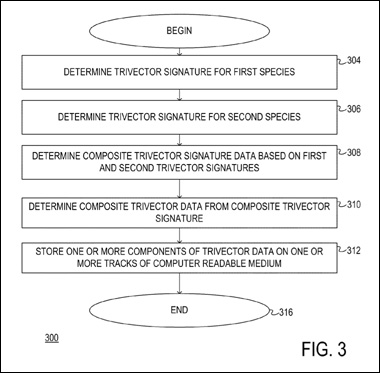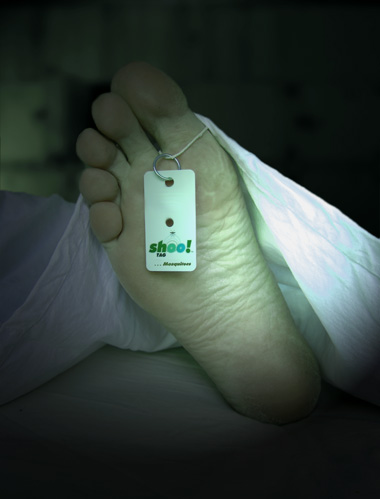Tue 7 Jun 2011
Shoo!TAG: Patently Absurd
Posted by anaglyph under Gadgets, Hokum, Idiots, In The News, Science, ShooTag, Skeptical Thinking, Technology, WooWoo
[32] Comments

One of my favourite places on teh intertubes is the massive US Patent Database. You really could, if you were so inclined, spend an entire rainy afternoon traipsing down its digital corridors and uncovering all manner of bizarre, and sometimes clever ideas. Along with hundreds of thousands of approved patents, you can also find in these dim dark recesses, an enormous slush pile of hopeful patent applications – the wannabees and the has-beens of the entrepreneurial universe.
It has to be said, though, that whoever is in charge of the USPTO doesn’t make the traipsing easy. If you’re looking for something in particular the system seems to do its very best to evade any kind of sensible search procedure. If it was my job to sort it out, I’d approach the people who do the database programming for, oh, Amazon, for instance, and get them to look into a better system for the filing, archiving and retrieving of patents and applications. Because the USPTO sure needs one.
On the other hand, maybe the impenetrable and unfriendly process suits aspiring entrepreneurs quite well, if, let’s say, a punter like myself is in search of a… certain item of interest. It’s quite possible that secretive inventor types hope that the labyrinthine process will cause potential patent sleuths to give up before they can steal any precious ideas, or, as is my particular intention today, before they can bring them out of the musty digital recesses of patent database anonymity and into the bright light of rational public scrutiny. ((I want to point out that there is absolutely nothing illegal about doing this – US Patent Applications are publicly available to anyone who wants to see them.))
The item of interest I have in mind is this one: US Patent Application #20100243745 for an APPARATUS AND METHOD FOR REPELLING AN UNDESIRED SPECIES FROM A SUBJECT SPECIES. Its inventors are listed as: Heiney; Kathryn M.; (Wimberley, TX) ; Dubounet; Desire; (Budapest, HU); Rogers Melissa M.; (Austin, TX). The document was published on September 30, 2010.
Yes, that’s right. You have surely recognized it as the patent application for ShooTag. ((ShooTag is also now being promoted as ‘ShooBug‘. New name, same old woo.)) And just in case I need to draw a line under the name, the patent application for ShooTag is jointly owned by Melissa Rogers, Kathy Heiney, and Desiré Dubounet, aka ‘Professor’ William Nelson.
As you will recall, I have previously demonstrated indisputable links between Nelson and ShooTag, in my post ShooTag; Waterloo, despite Melissa Rogers’ & Kathy Heiney’s apparent efforts to erase any associations between themselves and Nelson and his crackpot notions. ((Nelson is nowhere mentioned on the ShooTag site at the time of this writing, although he featured very prominently on their ‘Science’ page when ShooTag first came to my attention. In addition, Google links to Heiney and Rogers’ attendance at one of Nelson’s QXCI conferences in Budapest have been rendered invalid and are only retrievable via Google’s cache.))
To recap, William Nelson was indicted in 1996 by the U.S. Food and Drug Administration on nine counts of felony fraud charges in relation to various ‘bioenergetic’ healing devices sold through his companies (these machines go variously under the names ‘QXCI’, ‘SCIO’, ‘EPFX’ and others, but they are all basically similar flavours of the same woo. They are implicated in the deaths of several people and the prolonged illnesses of many more). To evade prosecution, Nelson abandoned his home in the USA to take up residence in Budapest, Hungary, where he currently resides in the persona of Desiré Dubounet, and is still actively promoting his/her odd beliefs and his dangerous ‘medical’ machines. ((Where he claims, in the manner of so many charlatans of medical pseudoscience, to have fled because of persecution by ‘Big Pharma’. The reasoning presumably goes that his wonderful machines have solved all the medical problems known to humankind and if the word got out, the pharmaceutical companies would go bust, and they won’t let that happen by hook or by crook. Of course, when it comes down to concrete results, Nelson’s machines don’t deliver. They are at their most ‘effective’ on those maladies that have vague symptoms and subjective outcomes – just like all pseudoscientific medicine. The deaths attributed to these dangerous gadgets are mostly the result of critically ill people being hoodwinked into using them rather than seeking proper medical care. And, folks, in some cases you get so sick that you will die, no matter what anyone does. Modern medicine can’t cure everything, but it has a damn better chance than a silly box fuelled by ‘trivector frequencies’.))
The reason that Heiney & Rogers and their company, Energetic Solutions, don’t want any public association with him/her is, to most observers, pretty obvious I think. Nelson/Dubounet is a wanted criminal and an out-and-out fruitcake, and Energetic Solutions finds him/her and his flaky ideas a liability to the sales of its product. ((It’s probable that Heiney and Rogers aren’t able to determine that Nelson’s ideas are flaky, but I think that they, or perhaps their PR people, are keenly aware that a cross-dressing woo-spouting mad ‘scientist’ does tend to come across as a complete lunatic to most people. One has to assume that originally, in their addled ‘quantum-fractal-Schumann-Wave-bioenergetic-magnetic’ enthusiasm, Heiney and Rogers were all for Nelson’s mad ideas, but somewhere along the line they realised that maybe it was better that they just gave him his cut of the profits and kept him in the closet.))
Now I will emphasize strongly, as I have done before, that merely associating with a criminal does not make a person themselves a criminal. It is not William Nelson’s crimes that concern us here. We can, however, legitimately ask whether there is any link between Nelson/Dubounet’s pseudoscientific beliefs – beliefs that underpin her machines and the practices which have been found fraudulent by the FDA and the law – and the supposed basis for the working mechanism of ShooTag.
With that thought in mind, let’s take a look at some of the ShooTag patent application.
The first thing that probably doesn’t have to be said is that there is an encyclopaedic volume of utter crap in this document. It leaps, like a frog on LSD, from one crazy lilypad of gibberish to another. It is, in fact, a version of the ‘science’ that was originally expounded on the ShooTag website, and which has been subsequently removed (presumably because it made no sense to anyone who knew anything about science).
And we see immediately some of the trademark ideas of William Nelson: ‘cyclic voltammetry‘ and ‘trivector signatures‘. Nelson/Dubounet has expounded upon these ideas all over the web, and the ‘trivector’ concept is focal in the machines he sells. The patent application offers up a flow chart of how the inventors propose that ShooTag would work:

Already we are in pixie land. ‘Determine’ the trivector signature for the species concerned? Now how, exactly, should one go about doing that? Well, Fig. 4 throws some light on that question:

Aha! A network connection to a ‘trivector database‘. Now, I wonder where someone might find such a database? Plugging the term ‘william nelson trivector database‘ into a search engine returns hundreds of results related to Nelson’s QXCI/SCIO/EPFX machines just like this one:
What is the EPFX (Electro Physiological Feedback Xrroid) Quantum Biofeedback Device ?It is the most accurate and sensitive technology of its kind for identifying stress reactions to over 10,000 trivector voltametric algorithmic signatures stored in it’s ((Ah yes, unsurprisingly, these sites are a tour de force of bad grammar, spelling and punctuation.)) database, such as those taken from nutritional items, emotional imponderable formulas, allersodes, toxins and more.
And elsewhere, on William Nelson’s very own ‘Imune’ website:
•Every substance has its own unique trivector (voltammetric) field signature, and it seems that when a substance with a voltammetric field signature is introduced to the body, it can provoke a change in the field of the body.
•This voltammetric field has a virtual photon effect, which also influences the body and changes its electrical readings. Thus, the trivector signature of an organism will change when the trivector of a stimulus is introduced electrically via device. With this, Nelson realizes an innovation in electrophysiological reactivity (EPR) testing.
• A system is developed for recording thousands of 3-Dimensional trivector “shapes†of individual substances, such as organs, toxins, allergens, nutrients, and others
I think we can very reasonably infer that the ‘trivector database’ specified in the ShooTag patent application is the very same ‘trivector database’ referred to in connection with Nelson/Dubounet’s fraudulent machines. How that database is determined is impossible to know. We can be quite certain there is no published science that explains what these ‘trivector substance signatures’ are. In my opinion, the patent should be refused on that basis alone; even nonsensical homeopathy ‘treatments’ are at least available for public perusal.
My assessment is that the QXCI/EPFX/SCSI/ShooTag ‘trivector database’ is nothing more than a big heap of spurious numbers that have no real meaning whatsoever. Of course, I can be proved entirely wrong about that with the offering up of some properly presented scientific evidence. I have no fear, however, that any such evidence will ever come my way.
The patent application goes rambling on over four dense pages of ‘explanation’, often repeating much of the same daft silliness in different wording. It comes from the school of ‘If-you-don’t-have-facts-throw-in-lots-of-baffling-sounding-terms’ thesis writing. The whole lot could be simply summed up in one brief paragraph:
‘We have a card with a magnetic strip upon which is encoded some numbers. Via some completely unspecified mechanism, some of those numbers refer to insects, and some of those numbers refer to pets. Via some other completely unspecified mechanism, the numbers working together cause the insects to avoid the pets.’ ((You can make it even shorter, in fact: ‘It’s a magic card that keeps bugs away.’))
That’s it.
Of course, the ShooTaggers know full well that they’d never have even the remotest chance of getting a patent if they said it like that, hence the mind-numbing verbage and circumlocutious gobbledygook. One hopes that the patent examiners are so used to seeing this kind of thing that the red pen comes out well before the end of the first paragraph.
Elsewhere on the patent application, we find other enlightening information. To set the scene: you will remember that a little while back we comprehensively decoded the ShooTag data and exposed the silly magical thinking inherent in the information encoded on the card. Not long after that, ShooTag added a question to the FAQ on their site in an obvious (if risible) attempt to deflect this exposure: ((Presumably their thought process was that people would search for ShooTag, find our deconstruction of the data, and then be mollified by the pat explanation in the FAQ. Nice try, folks.))
How do I know if my tag is still working?
This is a fun one. We encode shoo!TAG® tags with a frequency embedded in the magstripe located on the back of the tag. Customers can take their shoo!TAG® to any retailer that carries a magstripe (credit card) reader and swipe it through. The type of tag (i.e. fly, mosquito, tick) will show up when scanned. If there is no name, then the shoo!TAG® tag has lost its efficacy.
Yeah, that really is a fun one because we’ve caught you with your trousers down again. Let me quote you from your very own patent application (and it’s said not once, but three times, in different places):
…the trivector data stored on the three tracks is not readable by a conventional credit card reader.
Indeed. That statement tallies perfectly with my own experience: swiping a brand new ‘Tick’ card in a conventional card reader at my local shopping centre merely resulted in a ‘Card Read Error’. Maybe the ShooTaggers will want to amend that FAQ again, to erase this little untruth as well. Of course, this circumstance suits them down to the ground – if any ShooTag card is swiped, it will always come up as non-functioning (as it always literally is, I might point out). This is a ruse quite plainly intended to persuade unsuspecting customers to buy another one. Make no mistake, these people never miss a trick when money is involved.
So, what are we to make of this attempt by Energetic Solutions to obtain a patent? It’s not like they need it for any particular legitimate reason. The patent process exists in order to invest the intellectual property rights ownership of an invention with legal protection, so that someone else can’t take a good idea and just steal it. But here’s the thing – how do you protect an ‘invention’ that has no rational basis for doing what is claimed? ShooTag says their invention uses ‘trivector frequencies’ to achieve its stated purpose, so even if they had a proper patent, there would be nothing at all to stop me from creating a similar pet tag that uses a different method of operation to repel fleas, such as, oh, ‘overmodulated photonic recursion’ or something. When you just make shit up, holding a patent for it has no meaning.
But.
If your aim is to try and get authentic sounding endorsement for a product that can’t get any legitimacy via the path of factual evidence, then holding a patent is certainly a good PR tool. In other words, if you haven’t got any science to back up your claims, hoodwinking an official body into giving you an official seal of approval will undoubtedly buy you some mileage. ((It strikes me also that these people are prepared to put in a huge amount of time, effort, and, one assumes, money to try and establish their patent. Is it not a telling indication of how they view their product that they aren’t prepared to put the same kind of commitment into proper scientific trials? And wouldn’t you think you’d do the scientific investigation first? All legitimate product development happens that way round…))
I think most people trust that an organization such as the US Patent Office scrutinizes a document like the ShooTag application and files it where it belongs – under ‘N’ for ‘Nonsense’. Sadly, that trust would be misplaced. The USPTO rubber stamps some pretty stupid stuff. Take Patent #5,603,915 ‘Process for manufacturing homeopathic medicines’. Its inventors are listed as Carmel Kiely and a certain William Nelson. This ‘invention’ basically calls for the application of an electric current to a homeopathic medicine solution to ‘increase its efficacy’. Its rationale goes on for seven pages of ridiculous garbage.
And folks, the US Patent Office saw fit to award it a patent in 1997.
This enables William Nelson to boast, as he does whenever given the opportunity, about the many patents he holds. For people who don’t know better, it will undoubtedly sound impressive. This, I propose, is the sole reason that Energetic Solutions desires their patent for ShooTag. Not to protect its ‘clever technology’, but simply so they can use it as another advertisement. It’s exactly the same ploy that they’ve used with the ‘scientific experiment‘ that they tout on their website.
When you don’t have actual facts on your side, all you’ve got to play with is smoke and mirrors, and man, do these people know ALL the tricks.
Still, if they do get their patent approved, we will have something to look forward to. Melissa Rogers promised us that:
When we go from patent pending to full patent protection, then all of our sceince (all three applications) will be disclosed.
Well, Ms Rogers, such is my confidence of that ever happening that I’m applying for a patent to cover the event:






